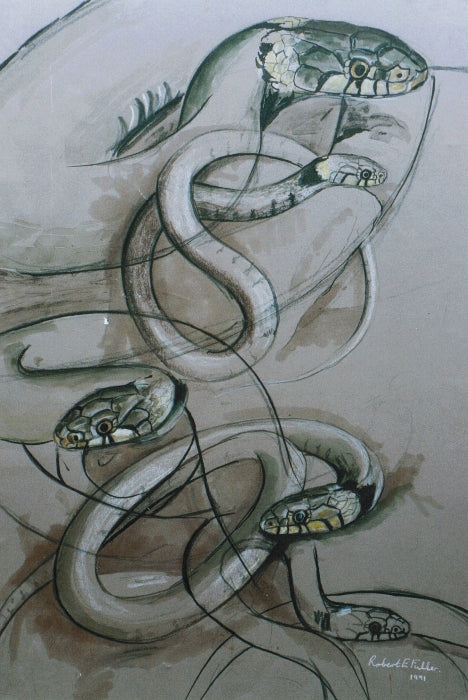 Grass Snake, painted by Robert E Fuller
Grass Snake, painted by Robert E FullerSnakes evoke a mixture of emotions, many of them negative. Adders in particular stir up a fair amount of hatred. Perhaps this is because they are this country’s only poisonous snake. And yet these reptiles are not actively aggressive. They only use their venom when hunting or as a last means of defense, usually if they are caught or trodden on. It is a shame they have such a bad press, because, of the three snake species native to the UK, adders are among the most attractive to the eye. The striking, blackish, zigzag pattern which runs the full length of their bodies is something I often itch to re-create in paint.
The base colour of an adder can be variable, from reddish brown to grey, greenish yellow or grey buff – so much more distinctive than a grass snake or a smooth snake. Adders can be found on heaths, moors, open woodlands and even coastal dunes. They spend of a lot of time basking in the sun and are less inclined to disappear into the undergrowth when disturbed, so they are probably the most frequently seen of British snakes. I like to take some time out in early spring, when they emerge from their hibernation dens, or in April, when they begin to mate, to look for them. One of my favourite places to go looking for adders in Yorkshire is Allerthorpe Common.
Adders eat small rodents, voles, mice and shrews – delivering their lethal shot of venom through hollow needle-like fangs before devouring them whole. But, as I discovered last week while watching five snakes in a ditch on Allerthorpe Common, lizards are also on the menu. There had been a frost overnight and the snakes were coiled up, basking in the sun for most of the morning which gave me plenty of opportunity to get some good photographs. By lunch time they began to get more active and I watched as one slithered along the top of the ditch. Suddenly, as it slunk into a patch of bracken, it coiled its neck back and struck out at something. Almost simultaneously, a common lizard flew through the air towards me and landed three feet away from the snake in the bottom of the ditch.
 Grass snake study sketch, by Robert E Fuller
Grass snake study sketch, by Robert E FullerI had seen a few lizards that day but was totally unaware of this one until the snake struck. The adder came to the edge of the ditch and started to make its way down the steep bank to look for the lizard, tasting the air with its forked tongue. Meanwhile the lizard lay utterly still in the spot that it had landed in. The snake clearly decided that the drop into the ditch was too steep and doubled back on itself. Just a couple of metres away, the bank fell away less sharply and the snake renegotiated its way down this gentler slope.
As it approached, the lizard re-positioned itself, turning to face the snake, and then froze again. This time it flattened its body into the foliage. As the snake made its way towards the lizard, again tasting the air with its forked tongue, it began investigating the bank, looking in every crevice and hole. The lizard held its nerve as the snake passed within a foot of it. The ploy clearly worked as the snake could not find its prey. I assume that there was no scent trail to follow since the lizard had vaulted into the ditch from the top of the bank. I breathed a sigh of relief as the snake passed by.
As soon as the coast was clear, the lizard set off at speed in the opposite direction, back up the bank and into thick cover. The hunt was over, until another day.














